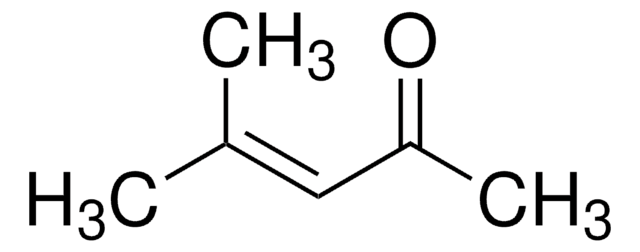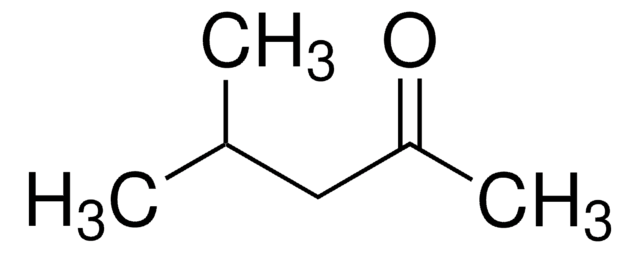49722
4-Methyl-3-penten-2-one
analytical standard
Synonym(s):
Mesityl oxide, 4-Methyl-3-penten-2-one
About This Item
Recommended Products
grade
analytical standard
Quality Level
assay
≥99.0% (GC)
shelf life
limited shelf life, expiry date on the label
technique(s)
HPLC: suitable
gas chromatography (GC): suitable
impurities
≤0.5% water
refractive index
n20/D 1.440-1.446
n20/D 1.442 (lit.)
bp
130 °C (lit.)
mp
-41.5 °C (lit.)
density
0.858 g/mL at 25 °C (lit.)
application(s)
cleaning products
cosmetics
flavors and fragrances
food and beverages
personal care
format
neat
SMILES string
C\C(C)=C\C(C)=O
InChI
1S/C6H10O/c1-5(2)4-6(3)7/h4H,1-3H3
InChI key
SHOJXDKTYKFBRD-UHFFFAOYSA-N
Looking for similar products? Visit Product Comparison Guide
General description
Application
Recommended products
signalword
Danger
Hazard Classifications
Acute Tox. 3 Inhalation - Acute Tox. 4 Dermal - Acute Tox. 4 Oral - Eye Irrit. 2 - Flam. Liq. 3 - Skin Irrit. 2 - STOT SE 3
target_organs
Respiratory system
Storage Class
3 - Flammable liquids
wgk_germany
WGK 1
flash_point_f
87.8 °F - closed cup
flash_point_c
31 °C - closed cup
Choose from one of the most recent versions:
Already Own This Product?
Find documentation for the products that you have recently purchased in the Document Library.
Customers Also Viewed
Our team of scientists has experience in all areas of research including Life Science, Material Science, Chemical Synthesis, Chromatography, Analytical and many others.
Contact Technical Service










